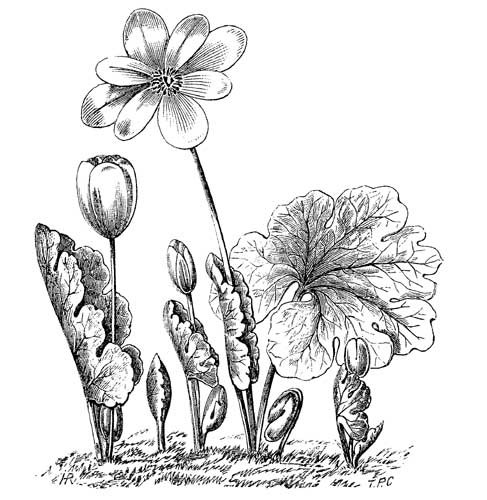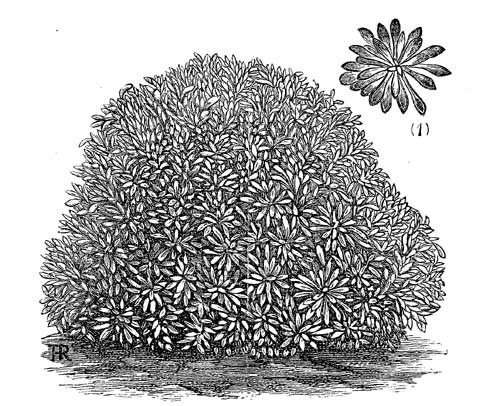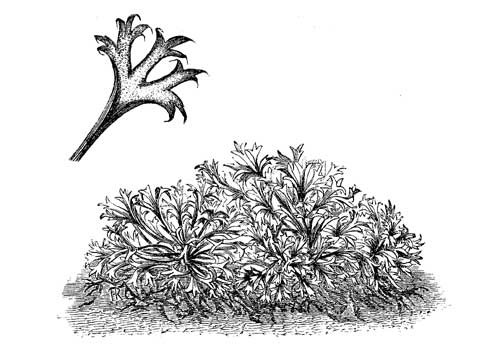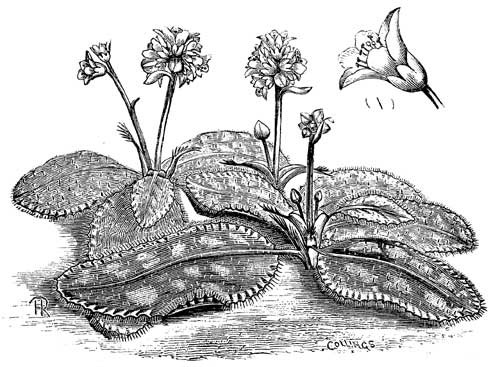 Полная версия
Полная версияHardy Perennials and Old Fashioned Flowers
I need not say anything respecting this form of flower in a cut state—its effectiveness is well known. If planted in ordinary garden loam it will hold its place and bloom freely year after year without further care. Smaller subjects should not be set too near it; it may be unadvisable to plant too many clumps in the same garden, but it can be allowed to spread into one bold patch. The best time to divide or transplant is in early spring, when growth is just pushing, for vigorous as this and many other perennials are, I have often found them to rot, when the dormant roots, after being cut into pieces, have had to face the winter.
Flowering period, July to September.
Rudbeckia Serotina
Late Cone-flower; Nat. Ord. CompositæThis hardy American species, though not an old plant in English gardens, is nevertheless classed with "old-fashioned" plants and flowers; and certainly its sombre but pleasing dark golden ray flowers, together with its likeness to many of the old sunflowers, favours such classification. It is the latest of a late-flowering genus.
It attains the height of 2ft.; the root leaves are of irregular shape, some oval and pointed, others, on the same plant, being lance-shaped, with two or three large teeth or acute lobes; in size the leaves also vary from 3in. to 8in. long, and being covered with short bristly hairs, they are very rough, also of a dull green colour; the flower stems have but few leaves, so it will be judged that the plant has but a weedy appearance, but this is compensated for by the rich and numerous large dark orange flowers, 3in. across; the ray is single, and the centre, which is large and prominent, is a rich chocolate brown.
This subject, to be effective, should be grown in large specimens; mine is about 3ft. in diameter, and the level mass of flowers, as I have often noticed them in twilight, were grandly beautiful. I can well understand that many have not cared for this cone flower when they have judged it from a small plant which has sent up its first, and perhaps abnormal, bloom. It is especially a subject that should be seen in bold clumps, and in moderately rich soil it will soon become such. Moreover, the flowers are very effective in a cut state, when loosely arranged in vases, only needing something in the way of tall grasses to blend with in order to form an antique "posy."
Autumn is the best time to plant it; its long roots denote that it enjoys deep soil, and, when planted, the roots of this, as well as all others then being transplanted, should be made firm, otherwise the frost will lift them out and the droughts will finish them off. Many plants are lost in this manner, and, indeed, many short-rooted kinds are scarcely saved by the greatest care. The stem-rooting character of this plant affords ready means of propagation by root divisions.
Flowering period, from September till strong frosts.
Salix Reticulata
Wrinkled or Netted Willow; Nat. Ord. SalicaceæA native deciduous shrub, of creeping or prostrate habit, not growing higher than 2in. As the flowers are inconspicuous and only interesting to the botanist or when under the microscope, let me at once say I mention this subject because of its beautiful habit and distinct quality of foliage. When grown on rockwork, no other plant can compare with it, and where choice spring bulbs are planted, this handsome creeper may be allowed, without injury to such roots, to broadly establish itself; so grown, its little stout leaves, thickly produced, flatly on the surface, are much admired.
The flowers or catkins stand well above the foliage, but are unattractive, being of a dusky brown colour; the leaves are dark green, downy, of much substance, 1½in. long, and nearly 1in. broad, but the size of foliage varies according to the conditions under which the specimens are grown; the sizes now referred to are of plants grown on rather dry rockwork and fully exposed; the form of the leaves is orbicular, obtuse, not in the least notched, bald, reticulately veined, and glaucous beneath; the stems are short and diffuse, and tinged with red on the younger parts.
During winter, when bare of foliage, its thick creeping stems, covered with fat buds and interlaced in a pleasing manner, render it interesting in almost any situation not shaded. It forms a capital carpet plant from early spring to the end of summer.
It is in no way particular as regards soil, and though it loves moisture, like most other willows, it proves thriving in dry places. It is, moreover, a good grower in large towns. Its propagation may be carried out before the leaves unfold in spring. Little branches with roots to them may be cut from the parent plant, and should be set in sandy loam and watered well to settle it about the roots.
Flowering period, September to strong frosts.
Sanguinaria Canadensis
Bloodroot; Nat. Ord. PapaveraceæThis is a native of North America, and is, therefore, hardy in this climate; tuberous rooted. It is a curious plant, not only from its great fulness of sap or juice, which is red (that of the root being darker, whence its name Bloodroot), but also because of the shape of its leaves, their colour, and method of development (see Fig. 81). Though very dwarf, it is handsome and distinct.
The flowers are pure white and nearly 2in. across; the petals have good substance, but they fall in five or six sunny days; the stamens are numerous and bright yellow. Though belonging to the order of the Poppy, it is in many respects unlike it; each flower stem, which is 6in. high, springs directly from the root, and only one flower is produced on a stem; the leaves are also radical, so that the plant is branchless and stemless; the leaf stalks are rather shorter than those of the flowers. The foliage is of a slate-grey colour, prominently veined on the under side, the upper surface being somewhat wrinkled; the leaves are 3in. across when fully developed, vine-leaf shaped, deeply and beautifully lobed; their development is slow, not being completed until the bloom is past. Both leaves and flowers are produced in a curious fashion; for a time the flower-bud is compactly enfolded by a leaf, and so both grow up to the height of 2in. or 3in., when the former pushes through, and soon swells its olive-shaped buds. At this stage a good specimen clump is very attractive, and is only more so when the fine blooms first open.

Fig. 81. Sanguinaria Canadensis.
(One-half natural size.)
It should be grown amongst some such carpeting plants as Sibthorpia Europæa or Linaria pilosa, so as to protect it; moreover, these creepers are suited for a similar soil and position. The soil should be light, either of sandy or vegetable character, but one that cannot bake; shade from the midday sun is essential, as also is plenty of moisture. When the growths have become crowded, as they do in about three years, it is as well to lift, divide, and replant at a distance of 3in.; this is best done after the tops have died off in summer; plant 4in. or 5in. deep.
Flowering period, April and May.
Saponaria Ocymoides
Rock Soapwort, or Basil-leaved Soapwort: Nat. Ord. SilenaceæA very hardy alpine from France, and one of the most floriferous subjects that can be placed on rockwork, where should be its position. During a single season it is no uncommon thing to see a small plant grow into a large cushion 2ft. in diameter, and only 6in. or 9in. high. In planting it this fact should not be overlooked, not only for the sake of giving it plenty of room, but also in order that less vigorous subjects near it may not become overgrown; it blooms all summer, and though the flowers are small and not at all bright, their numbers render it attractive.
The flowers, which are about ½in. across, are of a pink colour, and produced on many-branched prostrate stems; the calyx is five-toothed; the corolla is formed of five flat petals; the leaves are small, basil-like, oval-lance shaped, entire and smooth; the general appearance of the plant when in bloom is that of a compact mass of small leaves and flowers, the latter predominating.
It will grow in any kind of soil, but prefers that of a vegetable character, with its roots amongst large stones; but, strictly speaking, it needs nothing but an open situation and plenty of room to spread. It ripens an abundance of seed, and there is not a better mode of propagation than its own; hundreds of stout seedlings appear the following spring around the parent plant, and these may then be transplanted, and they will flower the same season.
S. o. splendens is a variety of the above very much improved indeed; and though one cannot discard the good old plant for its very recent offspring, the former is certainly very much eclipsed. Splendens has foliage slightly different, but its flowers are much larger and brighter; and though it may not be quite so vigorous, in this case that may be considered an improvement. It is said to come true from seed.
Flowering period, May to August.
Saxifraga Burseriana
Burser's Saxifrage; Nat. Ord. SaxifragaceæA hardy evergreen alpine. A native of Carniola, not long discovered, and quite new to English gardens. Though it belongs to a very extensive genus, it is a distinct species; many of the Saxifrages are not so, neither are they sufficiently decorative to merit a place in any but large or scientific gardens. This one, however, is a truly handsome kind, and its flowers are produced amid the snow and during the bleak and dull weather of mid-winter.
The plant in form is a dense cushion of little spiked rosettes, of a dark green colour, slightly silvered. The flowers are produced on bright ruddy stems 3in. high, and are creamy white, nearly the size of a sixpence. Small as the plant is, a moderate sized specimen is very attractive, especially before the flowers open, when they are in their prettiest form. They open slowly and endure nearly two months.
It enjoys light soil and a well drained situation, such as the edge of a border, where strong growing kinds cannot damage it, or on rockwork, where it will be fully exposed to the sun. To be effective, it should be grown into strong clumps, which may easily be done by annually giving a top-dressing of leaf-mould; the older parts of the plant will remain perfectly sound and healthy for years. When it is desirable to propagate it, it may best be done in April, when the tufts should be carefully divided, and its short roots made firm in the soil by one or two stones being placed near.
Flowering period, January to April.
Saxifraga Cæsia
Silver Moss, or Grey Saxifrage; Nat. Ord. SaxifragaceæOne of the alpine gems. This has been grown in English gardens since 1752, yet good specimens are rarely met with, though its culture is simple and easy. It is found wild on the Alps of Switzerland, Austria, and the Pyrenees. To the lover of the minute forms of genuine alpine plants, this will be a treasure; it is very distinct in form, habit, and colour. Its tiny rosettes of encrusted leaves can scarcely be said to rise from the ground, and the common name, "silver moss," which it is often called by, most fittingly applies; but perhaps its colour is the main feature of notice. The meaning of its specific name is grey, to which it certainly answers; but so peculiar is the greyness that a more definite description may be useful, in giving which I will quote that of Decandolle and Sprengle: "The lavender-blue is a pale blue (cæsius); it is mixed with a little grey." This exactly answers to the colour of the pretty Saxifrage under notice, and it is far from a common one in foliage.
The flowers differ but slightly from those of other encrusted forms of the genus, but they are a creamy white, arranged in small panicles on short and slender stems. They are sparingly produced in May and June. The leaves are ¼in. long, aggregate or in miniature rosettes; in shape, linear-oblong, recurved, and keeled. The upper surface is concave, having marginal dots, evenly disposed; the dots are bright and excavated, and some of the leaves (those of the stems) are scale formed. The glaucous or lavender-blue colour is beautifully enlivened with the crystal dots. Its habit reminds one of the more distinct forms of lichens, and, when it is grown with suitable companions on rockwork, it has a happy way of showing and adapting itself in such situation; besides, its colour then shows with more effect.

Fig. 82. Saxifraga Cæsia Major.
(1, single rosette, natural size.)
There is a variety of this species not yet in general cultivation, and it cannot be too strongly recommended to lovers of the finest forms of rock or alpine plants. It is called S. c. major (see Fig. 82). The name at once suggests the main difference from the type, but there are other features quite as marked as that of its extra size in all its parts; the foliage is more crowded, which seems to cause the largest leaves to become more erect, and the habit, too, perhaps from the same cause, is ball shaped; the small rosettes of thick encrusted leaves, from the manner in which they are packed together, form a rigid mass, which differs widely both in detail and effect from any other Saxifrage I know.
These dwarf subjects are best suited for rockwork; but another plan, now much practised, is to grow them in pots. This in no way implies that protection is given or needed—these sturdy subjects are far better fully exposed—but the pot system has advantages; when so planted, the roots are more likely to be placed in a better selected compost, and the specimens can be raised in order to examine their miniature beauties. The above kinds enjoy a gritty vegetable soil; perfect drainage is indispensable. These are not among the Saxifrages that are readily propagated; a few crowns or rosettes with short pieces of stem are not sure to root, and if more careful division is not carried out, perhaps but two or three growing bits from a large specimen may be the result, so lessening instead of increasing the stock. Before cutting let the roots be washed clear of soil, trace the long roots, and so cut up the plant that each division will have a share of them. Sometimes a rather large specimen will have but few of such roots, in which case it will prove the better and safer plan to make only a corresponding number of divisions, so making sure of each. A further help to such newly planted stock is gained by placing small stones about the collars; this keeps the plants moist and cool during the dry season, when (after flowering) the divisions should be made.
Flowering period, May and June.
Saxifraga Ceratophylla
Horn-leaved Saxifrage; Nat. Ord. SaxifragaceæFor the most part, this numerous genus flowers in spring and early summer, the species now under notice being one of the late bloomers; its flowers however, like most of the Saxifrages, are small and insignificant; on the other hand, its foliage, as may be seen by the illustration (Fig. 83) is highly ornamental. In November, the grand half-globular tufts of rigid dark green foliage are delicately furnished with a whitish exudation, which, seen through a magnifying glass, resembles scales, but seen by the naked eye—and it can be clearly seen without stooping—it gives the idea of hoar frost. We have here, then, an interesting and ornamental subject, which, when grown in collections of considerable variety, proves attractive; and as even after many degrees of frost, it retains its beauty, and, I may add, its finest form, it may be confidently recommended as a suitable winter garden subject. This species proves evergreen in our climate, though a native of Spain, from which country it was imported about eighty years ago. It is sometimes called S. cornutum, a name quite applicable, and it is frequently confounded with S. pentadactylis (the Five-fingered-leaved Saxifrage), which it much resembles, from which, however, it is distinct in several respects.

Fig. 83. Saxifraga Ceratophylla.
(Leaf, one-half natural size.)
Its flowers are small, white, and numerous, produced on slender stalks in summer; they are of the general type of the flowers of the mossy section, and need not be further described. The foliage forms rigid cushions, dense, rounded, and of a dark green colour in the early season; later it becomes grey, with an exudation; the leaves are arranged in rosette form, having stout stalks, channelled or folded on the upper surface; there are three deep divisions, and others less cut; the segments are subulate, bent back and tipped with horny mucrones, whence its specific name; these horn-like points are bent under, which, together with their transparency, renders them all but invisible; they can, however, be clearly seen if brought near the eye and looked for on the under side of the foliage. The leaves are of good substance, 1in. to 2in. long, having broad stipules; the stems are exceedingly slender in the older parts, and somewhat woody, having the appearance of being dried up and dead.
On rockwork it is seen in its best form, as the slope not only shows it off better, but is conducive to a finer growth. In flat places, the dense cushions, which are 6in. or 8in. high, often rot from too much moisture. I have never seen this occur in the drier positions afforded by the slopes of a rockery. If planted between large stones it has a happy way of adapting itself to them, and few plants are more effective. It thrives equally well in soil of a loamy or vegetable character, but it seems to enjoy a little limestone, small pieces of which I place round the specimens; they also serve to hold up the lower foliage and favour the admission of air. Where alpines are grown in pots this should form one, as it makes a charming specimen; the drainage should be perfect. It also makes a capital edging plant, especially for raised beds, as then it is accommodated in the same way as on rockwork.
It may be propagated by taking the slips nearest the earth, which will often be found to have a few rootlets, but if not they will still prove the more suitable; if taken in summer and dibbled into sand, they will make good roots in a week or two, when they may be transplanted to their permanent quarters, so as to become established before winter.
Saxifraga Ciliata
Hairy-margined Saxifrage; Syn. Megasea Ciliata; Nat. Ord. SaxifragaceæThis is a peculiar, distinct, and beautiful form of Saxifrage; there seems, however, to be some confusion in reference to its nomenclature. That it belongs to the Megasea section there can be little doubt, so that its synonym (M. ciliata) is fairly descriptive; but when it is said to be identical with S. ligulata, also of the Megasea section, the difficulty of recognising the form illustrated as such is very great indeed. It is also supposed to be a variety of S. ligulata, and though it has many important dissimilarities, it has also many affinities. So much does it differ from S. ligulata that it seems to be fully entitled to the specific honours which some authorities have given to it. It differs from S. ligulata, described by Don, in being rough and hairy on both sides of the leaves; in other respects it agrees, more especially in the colour of the flowers, which is uncommon. It may be the Megasea ciliata of Haworth, which Don refers to under S. ligulata, or it may be a distinct form of the latter, as, on the authority of Dr. Wallich, of the Botanical Gardens of Calcutta, the species has varieties. Wherever its proper place may be in its numerous genus, the name at the head hereof is a good descriptive one. It is an Indian contribution, hailing from the mountains east of Bengal. In this climate it endures our winters, though it is not one of the hardiest of its tribe. It has not long been cultivated in this country, and is rarely met with. Its distinct habit and fine flowers render it desirable, and it will with many be more so on the score of its peculiarities. A few of the latter may be mentioned here. Anthers very large, and brick-red before becoming pollenized; scapes and scape-sheaths nearly smooth, though all other foliar parts are hairy; stipules very large and fully developed whilst the leaves are in their rudimentary stage. When not in flower the plant has a strong resemblance to S. sarmentosa, which belongs to another section, but S. ciliata has features belonging to both sections. The habit, however, is more flat, and leaves more oval, and if, as has been hinted, this is a hybrid, it may not be without some relationship to that species, which is also of Asian origin. Further, on the authority of Murray, Sax. sarmentosa is identical with S. ligulata; so that, if we may suppose S. ciliata to be a distinct variety of S. ligulata, and the latter to have such affinity to S. sarmentosa that Murray puts it as identical, the chief difference between our subject and the form generally accepted as S. ligulata is accounted for, viz., the hairy and rougher surfaces of the leaves, which are traits of the well-known S. sarmentosa. If these remarks prove nothing, they may serve to show the difficulty of recognising the various forms and species of so popular a genus from reading alone, it having been so extensively treated of, and the classifications being so varied. Its study, when the species are being cultivated, is simply delightful, compared with the confusion of book study alone; and yet it is no uncommon thing, when forming a collection of Saxifrages, to receive three or four different forms from different sources under the same name, and each perhaps more or less authorised. The student by growing this genus of plants will reap other pleasures than that of identification, and in a few years time will find in his own garden (as the outcome of growing allied species) new forms springing from seed, and scattered about the beds and walks in a pleasing and suggestive manner. (See Fig. 84.)

Fig. 84. Saxifraga Ciliata.
(One-fourth natural size; (1) two-thirds natural size.)
The present subject has bell-shaped flowers, arranged in short-branched panicles, each flower ¾in. across, and sometimes, when well expanded, quite an inch; the colour is a delicate pink-tinted white; petals obovate and concave, inserted in the calyx, clawed, sometimes notched and even lobed; stamens long as petals, inserted in throat of calyx, stout, green changing to pink; anthers large and brick red when young; styles massive, joining close together, turgid, nearly long as stamens, and pale green; stigmas, simple, beardless, turning to a red colour; calyx bell-shaped, five-parted, wrinkled; segments slightly reflexed and conniving or joining; scapes 4in. to 6in. high, stout and smooth, excepting solitary hairs; bracts, leaf-like; leaves oval or cordate, 2in. to 4in. long, wrinkled, slightly waved, and toothed, conspicuously ciliated or haired on the margin, whence the specific name "ciliata." Both surfaces are also furnished with short stiff hairs, the whole leaf being stout and flatly arranged; leaf stalks short, thick, and furnished with numerous long hairs, and ample stipules, which are glabrous, but beautifully ciliated. Roots, woody, and slightly creeping on the surface. Habit of foliage reflexing, forming flat masses; smaller or supplementary scapes are sent up later than the main scape, from the midst of the stipules, bearing flowers in ones and twos. The blossom, which is effective and very beautiful, is also sweetly scented, like the hawthorn.
As already hinted, this is not one of the most hardy Saxifrages, but I have twice wintered it out on gritty beds, well raised, also on rockwork, under a warm south wall; and, as such positions can be found or made in most gardens, it would be advisable to try and establish this distinct and lovely spring bloomer. Lime and sandstone grit mixed with loam and leaf soil I find to be the best compost I have yet tried for it; in fact, until a dry situation and a little lime were given, it proved a shy bloomer. It is now quite the reverse, notwithstanding that the roots were divided during the previous autumn. Fogs and rain are its greatest plagues, owing to its hairy nature; the glass and wire shelters should be used for this most deserving subject. Propagated by division of the woody semi-creeping roots during early autumn; each division should have a crown and some roots, when they may be planted in their permanent quarters.



